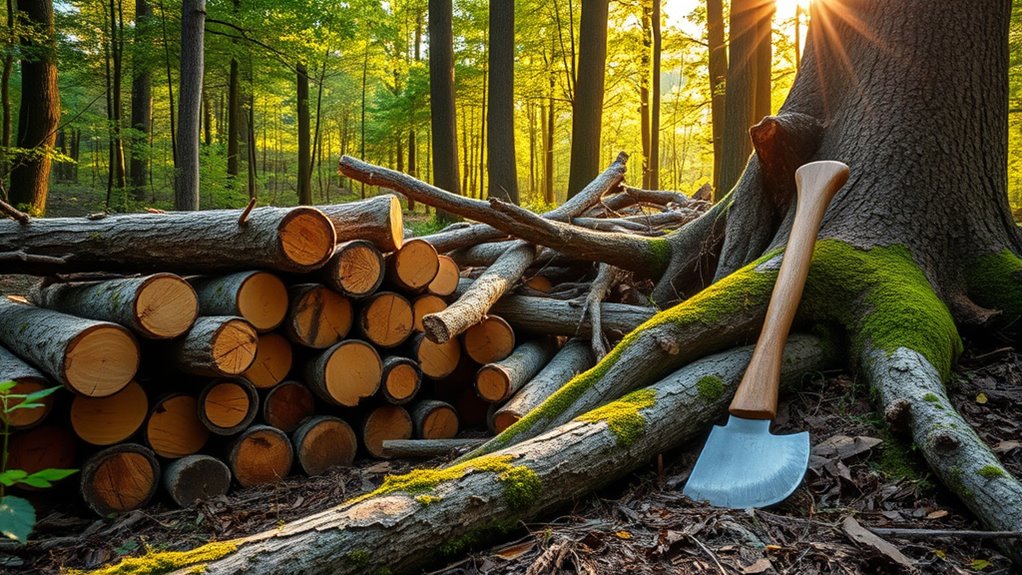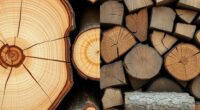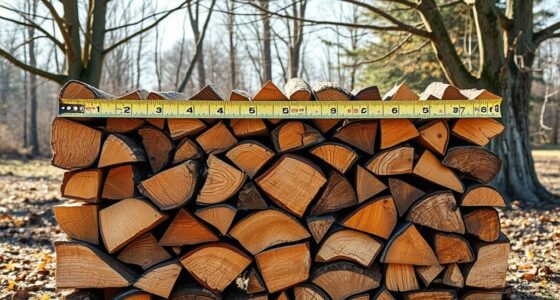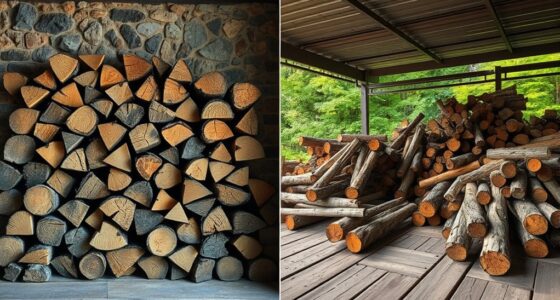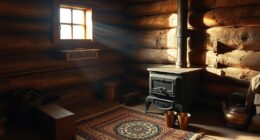Using dead or downed trees for firewood is a sustainable choice that benefits both your heating needs and the environment. It helps reduce forest clutter, lowers fire hazards, and supports ecological health by recycling nutrients naturally. When collecting, be mindful to select only fully dried, fallen wood and avoid disturbing wildlife habitats. Responsible use guarantees forests stay healthy for future generations. Keep exploring to discover more ways to make eco-friendly firewood choices that preserve nature’s balance.
Key Takeaways
- Collect fully dried, naturally fallen deadwood to ensure sustainable firewood sourcing.
- Avoid removing entire deadwood areas to protect wildlife habitats and ecological functions.
- Deadwood provides an eco-friendly, low-moisture fuel that reduces environmental impact compared to cutting live trees.
- Follow local regulations and forest management guidelines to prevent overharvesting and habitat disruption.
- Using dead or downed trees supports forest health, nutrient recycling, and biodiversity conservation efforts.
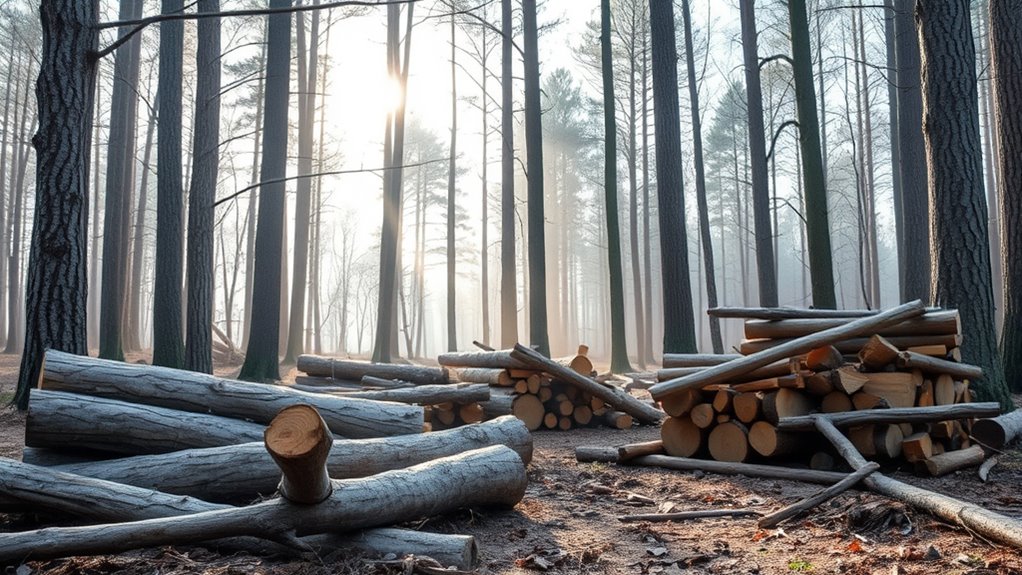
Have you ever contemplated how dead or downed trees can provide a sustainable source of firewood? When managed properly, using these trees can be an eco-friendly alternative to cutting live trees, especially if you’re mindful of forest management practices. By collecting fallen branches and deadwood, you help reduce clutter and prevent potential fire hazards, all while minimizing your impact on the environment. This approach supports ecological balance because it allows forests to naturally recycle nutrients as decomposing wood enriches the soil. Properly managing deadwood removal ensures that forests stay healthy without disturbing living trees or disrupting wildlife habitats, which is crucial for maintaining biodiversity.
Engaging in responsible forest management means understanding which dead trees are suitable for firewood and which should be left alone. Removing only those that have fully dried and fallen naturally prevents unnecessary disturbance to the ecosystem. It’s important to avoid stripping entire areas of deadwood, as it provides habitat for insects, fungi, and small animals. These organisms play critical roles in nutrient cycling and soil health, so preserving some deadwood helps sustain the ecological impact of the forest. When you collect dead or downed trees, do so selectively and thoughtfully, recognizing that your actions influence the overall health of the forest.
Using deadwood as firewood also reduces the need for harvesting live trees, which can be detrimental if done excessively or irresponsibly. This sustainable practice aligns with conservation efforts because it minimizes deforestation and forest degradation. Plus, dead trees often have a lower moisture content, making them excellent for burning and providing an efficient heat source. By prioritizing dead or fallen trees for firewood, you’re supporting a cycle that benefits both the environment and your energy needs. It’s a practical way to be eco-conscious while enjoying a reliable, renewable heat source.
However, it’s essential to contemplate ecological impact beyond just the immediate benefits. Collecting firewood from dead trees should be part of a broader, sustainable forest management plan that respects local regulations and conservation priorities. Avoid overharvesting and ensure that your collection practices don’t disturb wildlife or damage the forest structure. Responsible collection helps maintain the biodiversity and resilience of forests, ensuring they continue to thrive for future generations. With responsible planning, using dead or downed trees becomes a way to contribute to forest health rather than compromise it. By balancing your firewood needs with ecological considerations, you help ensure that forests remain resilient and productive for generations to come.
Frequently Asked Questions
How Do I Identify Safe Dead or Downed Trees for Firewood?
To identify safe dead or downed trees for firewood, look for healthy tree indicators like intact bark and absence of fungi or rot. Avoid trees with signs of disease or insect infestation. Use wood moisture testing to verify the wood is seasoned, ideally below 20% moisture, which burns efficiently and safely. Trust your judgment and prioritize trees that show clear health indicators and proper dryness for safe, sustainable firewood.
Are There Legal Restrictions on Collecting Dead or Downed Trees?
You need to check local regulations first, as there are legal considerations when collecting dead or downed trees. Many areas require collection permits, especially on public lands, to prevent illegal harvesting and protect ecosystems. Always verify with land management agencies or local authorities before gathering firewood. Ignoring these rules can lead to fines or legal action. Being informed guarantees you’re collecting responsibly and legally.
How Should I Store Firewood to Prevent Pests and Decay?
You should store firewood in a dry, well-ventilated area to prevent pests and decay. Keep the wood elevated off the ground using pallets or racks to promote moisture control and air circulation. Cover the top with a tarp or metal roof, but leave the sides open to guarantee proper airflow. Regularly inspect your firewood for signs of pests or mold, and rotate the stack to use the oldest wood first.
What Safety Precautions Are Necessary When Handling Fallen Trees?
When handling fallen trees, you should wear personal protective equipment like gloves, goggles, and sturdy boots to prevent injuries. For example, a homeowner once injured their hand while moving a heavy branch without gloves. Always stay aware of fire hazards, avoiding sparks or open flames near dried wood. Use proper tools and techniques to minimize risks, and never work alone if the tree is unstable, ensuring your safety.
Can Using Dead Trees Impact Local Ecosystems or Wildlife?
Using dead trees can affect local ecosystems and wildlife habitat if you’re not careful. Removing too many dead trees can disturb the ecosystem balance, reducing shelter for insects, birds, and small mammals. To minimize impact, only harvest dead trees selectively and avoid disrupting essential habitats. By doing so, you help preserve wildlife habitat and maintain ecosystem health while responsibly gathering firewood.
Conclusion
Using dead or downed trees as firewood is a sustainable choice, helping reduce waste and prevent the spread of pests. Some believe this practice might deplete local ecosystems, but studies show that responsibly sourcing such wood actually supports forest health by removing fallen debris. As long as you select trees ethically and avoid disturbing live ones, you can enjoy a warm fire while contributing positively to the environment. It’s a balanced approach that benefits both your home and the forest.

